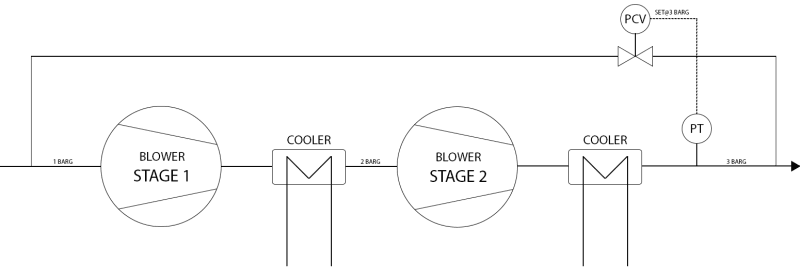hirschaplin
Petroleum
I am looking for a fundamental explanation on how the pressure distribution happens and works in a 2-stage roots blower setup.
I am familiar with blowers and fully accept and understand the following working principle given by CAGI about the functionality:
If we look at this example:

My questions are:
- How is the pressure distribution handled? What is given resistance to stage 1, is it stage 2 that causes the pressure differential in stage 1 but why? I understand it is related to the blower rpm and the different gas volumes before and after each stage. But why isn't the full differential pressure taken by Stage 2?
- What happens if the flow is not in symbios between stage 1 and 2? For example if stage 1 put through 1000 Nm3/h but the rpm of stage 2 allows for 950 Nm3/h or 1050 Nm3/h? What happens with the 50 Nm3/h difference? I understand it would still be OK but the pressure would slightly change either up or down depending on if you starve or overfeed the second stage.
Please explain it for a 10 year old that believes in a flat earth.
Thank you
I am familiar with blowers and fully accept and understand the following working principle given by CAGI about the functionality:
CAGI said:The rotary, positive displacement blower works on a very simple principle. See
Figure 6.1. As the drive shaft is rotated, the impellers turn in opposite directions
with very finite clearances between each other and between the rotors and the casing.
As each impeller passes the inlet, a measured quantity of air is trapped between
the impellers and the casing. As the shafts continue to rotate, this
“pocket” of air is transported around the casing to the discharge side of the
machine, where it is then expelled through the port, against the pressure prevailing
in the discharge line. When this occurs, a back flow of air into the “pocket” from
the higher pressure discharge line produces a constant volume pressure rise, causing
a pressure pulse resulting in noise. As a “pocket” of air is expelled four times
with each revolution of the drive shaft, or twice with each impeller, the fundamental
frequency of the pressure pulse is four times the shaft speed.
If we look at this example:

My questions are:
- How is the pressure distribution handled? What is given resistance to stage 1, is it stage 2 that causes the pressure differential in stage 1 but why? I understand it is related to the blower rpm and the different gas volumes before and after each stage. But why isn't the full differential pressure taken by Stage 2?
- What happens if the flow is not in symbios between stage 1 and 2? For example if stage 1 put through 1000 Nm3/h but the rpm of stage 2 allows for 950 Nm3/h or 1050 Nm3/h? What happens with the 50 Nm3/h difference? I understand it would still be OK but the pressure would slightly change either up or down depending on if you starve or overfeed the second stage.
Please explain it for a 10 year old that believes in a flat earth.
Thank you
